Mary Anne Yarde's Blog: The Coffee Pot Book Club , page 141
April 29, 2019
Celebrating 35 years of Robin of Sherwood: Special Guest Interview — Jason Connery #RobinOfSherwood @JasonJasonjcon
Nothing’s forgotten. Nothing is ever forgotten.
Celebrating 35 years of Robin of Sherwood.
Exclusive Guest Interview
Jason Connery

As the sunlight splinters in a thousand pieces upon the forest floor, we once again find ourselves in Sherwood. This is an ancient land, a strange one where the morning mist hints at the myths and legends that this green canvas inspires.
We are continuing with our celebrations of all things Robin of Sherwood today, and it is my very great pleasure to welcome Jason Connery onto the blog. For those who are fans of the show, and for those of you who are checking out the show for the first time, Jason took on the iconic role of Robin Hood in 1986.
Hi Jason, welcome to Myths, Legends, Books & Coffee Pots. It is so fabulous that you could join us today and talk about Robin of Sherwood.
When the credits rolled at the end of The Greatest Enemy, which saw the death of Michael Praed’s beloved character Robin of Loxley, the fans were left with a promise of a new Hooded Man and a continuation of the story.
How did you come by the role of Robert of Huntingdon?
I was called by my agent who said they were re-casting “Robin” for Robin of Sherwood and they were looking for someone quite different from Michael, as they had an idea for a completely different character, that actually Robin was an amalgam of different people and that one of the stories was of an Earl’s son.
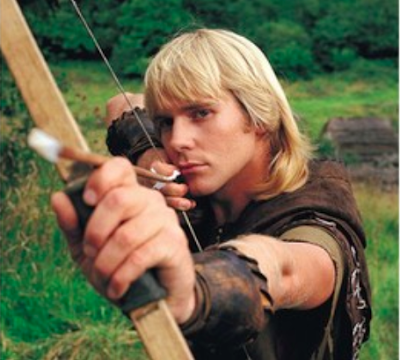
Straight away there was a notable difference between your character and Michael’s, and you certainly brought something wonderfully new to the series. Were you a fan of the show before you became a part of it?
I knew of the show, but had been working in the theatre quite a bit and so I was on stage on Saturdays, and recording shows was not big back then!!
What was the first day on set like?
Well there was quite a lead in to the first show, I had been practicing all sorts of fighting with the other Merries, so I had got to know them a bit before starting. The first episode I did was actually Adam Bell and it was lovely to start with a story about a man who used in some ways to be a Robin Hood character back in the day and Bryan Marshall was lovely to work with, so my first day, although scary was so much fun!
"Adam Bell" was a fantastic episode, and Bryan Marshall made a fabulous antagonist. I think we can all agree that you brought something very new to the story in your characterisation of Robin. How much influence did you have on how you portrayed him?
Kip Carpenter the writer was such an amazing man so full of fun and he loved to tell stories obviously, he was very open to us all bringing ideas, and he and I did spend a lot of time with Judi talking about how she and I would get together as it was incredibly important that she had time to get over her lose. We also spoke a lot about how I was to bring the Merries back together and not just round them up and off we go, they needed to really want to follow a new leader.

Which leads me very nicely into the next question. In the opening episodes of Season 3, Robert finds himself in some very sticky situations. Not only does he have to fight Lord Owen of Clun, but he also has to fight several merry men — including Will Scarlet, as he tries to convince them of his worth. The fight scenes were superbly choreographed and very memorable. Of all the weapons that Robin uses, which one was the most challenging to get to grips with?
Luckily, I had done some sword fighting in past jobs so that was okay, but I did get bashed on the head with Clive’s staff in the fight scene we had in the opening double episode, forgot to cover for the top shot!! Which of course Clive thought was hilarious!! But I think in some ways the hardest was firing the bow and arrow at speed, if you don’t nock the arrow exactly right, it all goes wrong very quickly and if your Robin and it goes wrong, your street cred goes out the window!!!
It would not do for Robin to miss his target! I have had a go at using a longbow and it not easy, you, of course, made it look simple! There are some very memorable villains in Robin of Sherwood. Your character’s nemesis was, with the exception of the Sheriff of Nottingham and Sir Guy of Gisborne, Gulnar — played by the fabulous Richard O'Brien. Who was your favourite villain in the series and why?
There were so many villains in ROS, it’s tough to name one, of course Richard O’Brien came back a number of times so we did get to know him better than the rest of the guest stars and he was great fun to work with always looking for different ways to stir up the magical side of his abilities. Another great Villain was Valentine Pelka who played Sarak, he was the strong silent type and his swordplay did his talking, great fight between him and Mark Ryan.
The sword fight between Mark and Valentine was amazing. What was your most memorable scene while filming?
I will say one of the most memorable was getting my eyebrows and full fringe burnt off my face when standing over the lake in Cromm Cruac, there was just meant to be a small fire explosion over the lake, but it was a lot bigger than intended, the look on the make-up girls face when she saw me was “Memorable”!! But honestly there was so many, it was such a joy to go to work everyday. I am friends to this day with all the Merries and many of the rest of the cast and crew. It was quite early in my career and I thought all jobs were like that but actually they aren’t and I do feel so blessed to have been part of the show and the people in it.
Oh, my goodness, I can see why that would be memorable! Apart from the singed hair and eyebrows, did Robin of Sherwood change your life in any way?
It did in so many ways. I had never worked with such an array of people and for an extended amount of time. I was on television every Saturday for a while and experienced being a known face, which was very new to me, I had seen it with my Dad but had not experienced it myself, it opened up my career to many other jobs and I traveled all over the world, but best in some ways, it gave me some of the closest friends who I adore to this day.
Moving away from Robin of Sherwood very briefly. What made you decided to come away from working in front of the camera, and become a director?
I really feel it is a natural transition, I love telling stories and to be able to do it from not just one perspective but from many and encompass the whole story is a lot more work and commitment but incredibly rewarding.
You are also very supportive of the next generation of filmmakers, and you are a patron of The Bath School of Acting. How important is it to you, to encourage future filmmakers?
I do think it’s important. Back in LA I started something called “Short Mondays” where film makers could show their shot films and then do a Q and A afterwards. I did a play with Tristan Carter who runs The Bath School of Acting and he asked me to be involved, I think passing on anything that might be of use and connecting people together is the framework for a successful society.
Let’s head back to Sherwood...
I am sure many of Robin of Sherwood’s loyal fans know that in recent years you and several members of the cast have worked with Barnaby Eaton-Jones and Spiteful Puppet to bring us a Robin of Sherwood audio drama. What was your initial reaction when you were asked if this was something you would like to be a part of? What was it like to be back almost thirty years later, playing Robin?
I was quite surprised about how protective I felt about the show and also the fans that love it. I didn’t want to do something that was a pale copy of the original, in fact we all talked about that a lot. The script used was an actual “Kip” script that was never made, and we all knew Barnaby from the conferences, so there was a level of trust. The most rewarding part was actually watching the fans faces listening to the 5 minute promo that was played when we all met up, it was very moving to see them all close their eyes and hear new words being spoken for the first time, by characters they knew and loved.
Thirty-five years on and Robin of Sherwood is still enjoyed by so many people. What kind of legacy do you hope Robin of Sherwood will leave for future generations?
Of course when you make a show, you hope people like it, but you never think “will they like it in 35 years time”!!! If people continue to garner enjoyment from the show, I couldn’t ask for anything more. When we do conventions and fans bring their children, who they have introduced to the show and they also love it, even if they are quite confused about why I don’t look anything like the Robin they have watched on ROS!!

Jason Connery (Robin) , Mark Ryan (Nasir) , Clive Mantle (Little John), Peter Llewellyn Williams Much), Phil Rose (Friar Tuck).
Thank you so much Jason, for taking the time out to talk about Robin of Sherwood with us today!!
Now, dear readers, it is over to you. What is your favourite episode of Robin of Sherwood and why?
Pop your answers in the comments.
Celebrating 35 years of Robin of Sherwood.
Exclusive Guest Interview
Jason Connery

As the sunlight splinters in a thousand pieces upon the forest floor, we once again find ourselves in Sherwood. This is an ancient land, a strange one where the morning mist hints at the myths and legends that this green canvas inspires.
We are continuing with our celebrations of all things Robin of Sherwood today, and it is my very great pleasure to welcome Jason Connery onto the blog. For those who are fans of the show, and for those of you who are checking out the show for the first time, Jason took on the iconic role of Robin Hood in 1986.
Hi Jason, welcome to Myths, Legends, Books & Coffee Pots. It is so fabulous that you could join us today and talk about Robin of Sherwood.
When the credits rolled at the end of The Greatest Enemy, which saw the death of Michael Praed’s beloved character Robin of Loxley, the fans were left with a promise of a new Hooded Man and a continuation of the story.
How did you come by the role of Robert of Huntingdon?
I was called by my agent who said they were re-casting “Robin” for Robin of Sherwood and they were looking for someone quite different from Michael, as they had an idea for a completely different character, that actually Robin was an amalgam of different people and that one of the stories was of an Earl’s son.

Straight away there was a notable difference between your character and Michael’s, and you certainly brought something wonderfully new to the series. Were you a fan of the show before you became a part of it?
I knew of the show, but had been working in the theatre quite a bit and so I was on stage on Saturdays, and recording shows was not big back then!!
What was the first day on set like?
Well there was quite a lead in to the first show, I had been practicing all sorts of fighting with the other Merries, so I had got to know them a bit before starting. The first episode I did was actually Adam Bell and it was lovely to start with a story about a man who used in some ways to be a Robin Hood character back in the day and Bryan Marshall was lovely to work with, so my first day, although scary was so much fun!
"Adam Bell" was a fantastic episode, and Bryan Marshall made a fabulous antagonist. I think we can all agree that you brought something very new to the story in your characterisation of Robin. How much influence did you have on how you portrayed him?
Kip Carpenter the writer was such an amazing man so full of fun and he loved to tell stories obviously, he was very open to us all bringing ideas, and he and I did spend a lot of time with Judi talking about how she and I would get together as it was incredibly important that she had time to get over her lose. We also spoke a lot about how I was to bring the Merries back together and not just round them up and off we go, they needed to really want to follow a new leader.

Which leads me very nicely into the next question. In the opening episodes of Season 3, Robert finds himself in some very sticky situations. Not only does he have to fight Lord Owen of Clun, but he also has to fight several merry men — including Will Scarlet, as he tries to convince them of his worth. The fight scenes were superbly choreographed and very memorable. Of all the weapons that Robin uses, which one was the most challenging to get to grips with?
Luckily, I had done some sword fighting in past jobs so that was okay, but I did get bashed on the head with Clive’s staff in the fight scene we had in the opening double episode, forgot to cover for the top shot!! Which of course Clive thought was hilarious!! But I think in some ways the hardest was firing the bow and arrow at speed, if you don’t nock the arrow exactly right, it all goes wrong very quickly and if your Robin and it goes wrong, your street cred goes out the window!!!
It would not do for Robin to miss his target! I have had a go at using a longbow and it not easy, you, of course, made it look simple! There are some very memorable villains in Robin of Sherwood. Your character’s nemesis was, with the exception of the Sheriff of Nottingham and Sir Guy of Gisborne, Gulnar — played by the fabulous Richard O'Brien. Who was your favourite villain in the series and why?
There were so many villains in ROS, it’s tough to name one, of course Richard O’Brien came back a number of times so we did get to know him better than the rest of the guest stars and he was great fun to work with always looking for different ways to stir up the magical side of his abilities. Another great Villain was Valentine Pelka who played Sarak, he was the strong silent type and his swordplay did his talking, great fight between him and Mark Ryan.
The sword fight between Mark and Valentine was amazing. What was your most memorable scene while filming?
I will say one of the most memorable was getting my eyebrows and full fringe burnt off my face when standing over the lake in Cromm Cruac, there was just meant to be a small fire explosion over the lake, but it was a lot bigger than intended, the look on the make-up girls face when she saw me was “Memorable”!! But honestly there was so many, it was such a joy to go to work everyday. I am friends to this day with all the Merries and many of the rest of the cast and crew. It was quite early in my career and I thought all jobs were like that but actually they aren’t and I do feel so blessed to have been part of the show and the people in it.
Oh, my goodness, I can see why that would be memorable! Apart from the singed hair and eyebrows, did Robin of Sherwood change your life in any way?
It did in so many ways. I had never worked with such an array of people and for an extended amount of time. I was on television every Saturday for a while and experienced being a known face, which was very new to me, I had seen it with my Dad but had not experienced it myself, it opened up my career to many other jobs and I traveled all over the world, but best in some ways, it gave me some of the closest friends who I adore to this day.
Moving away from Robin of Sherwood very briefly. What made you decided to come away from working in front of the camera, and become a director?
I really feel it is a natural transition, I love telling stories and to be able to do it from not just one perspective but from many and encompass the whole story is a lot more work and commitment but incredibly rewarding.
You are also very supportive of the next generation of filmmakers, and you are a patron of The Bath School of Acting. How important is it to you, to encourage future filmmakers?
I do think it’s important. Back in LA I started something called “Short Mondays” where film makers could show their shot films and then do a Q and A afterwards. I did a play with Tristan Carter who runs The Bath School of Acting and he asked me to be involved, I think passing on anything that might be of use and connecting people together is the framework for a successful society.
Let’s head back to Sherwood...
I am sure many of Robin of Sherwood’s loyal fans know that in recent years you and several members of the cast have worked with Barnaby Eaton-Jones and Spiteful Puppet to bring us a Robin of Sherwood audio drama. What was your initial reaction when you were asked if this was something you would like to be a part of? What was it like to be back almost thirty years later, playing Robin?
I was quite surprised about how protective I felt about the show and also the fans that love it. I didn’t want to do something that was a pale copy of the original, in fact we all talked about that a lot. The script used was an actual “Kip” script that was never made, and we all knew Barnaby from the conferences, so there was a level of trust. The most rewarding part was actually watching the fans faces listening to the 5 minute promo that was played when we all met up, it was very moving to see them all close their eyes and hear new words being spoken for the first time, by characters they knew and loved.
Thirty-five years on and Robin of Sherwood is still enjoyed by so many people. What kind of legacy do you hope Robin of Sherwood will leave for future generations?
Of course when you make a show, you hope people like it, but you never think “will they like it in 35 years time”!!! If people continue to garner enjoyment from the show, I couldn’t ask for anything more. When we do conventions and fans bring their children, who they have introduced to the show and they also love it, even if they are quite confused about why I don’t look anything like the Robin they have watched on ROS!!

Jason Connery (Robin) , Mark Ryan (Nasir) , Clive Mantle (Little John), Peter Llewellyn Williams Much), Phil Rose (Friar Tuck).
Thank you so much Jason, for taking the time out to talk about Robin of Sherwood with us today!!
Now, dear readers, it is over to you. What is your favourite episode of Robin of Sherwood and why?
Pop your answers in the comments.
Published on April 29, 2019 23:30
Children's #HistoricalFiction author, Michael E Wills, is talking about the hidden messages he found while researching the Viking era. Check out Michael's fabulous book — Bound for Home. @MWillsofSarum
Messages from the past by Michael E Wills
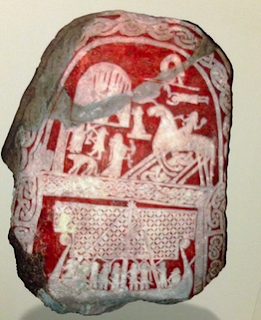 What we know about the Viking Age comes almost entirely from the accounts of their victims. The very useful Anglo-Saxon Chronicle is, understandably, coloured by outrage at the raiding, plundering and murder perpetrated by the Norsemen. The description of the Vikings written by Adam of Bremen in his "History of the Archbishops of Hamburg", is also valuable, but it is not contemporaneous as he wrote around 1070, nor is his information gained at first hand. The Icelandic Sagas were written well after the Viking Age and are based on oral tradition.
What we know about the Viking Age comes almost entirely from the accounts of their victims. The very useful Anglo-Saxon Chronicle is, understandably, coloured by outrage at the raiding, plundering and murder perpetrated by the Norsemen. The description of the Vikings written by Adam of Bremen in his "History of the Archbishops of Hamburg", is also valuable, but it is not contemporaneous as he wrote around 1070, nor is his information gained at first hand. The Icelandic Sagas were written well after the Viking Age and are based on oral tradition. However, there are two other sources which are contemporary. Firstly, some Arab travellers wrote about Vikings they met on the Eastern European trade routes. They described their social and personal habits, (definitely not admired), their dress and customs.
Secondly, there are the records kept by the Vikings themselves in the form of runic carvings. These messages are sometimes cryptic, but they can give the researcher vital clues to the travels and ways of life and death of the Vikings.
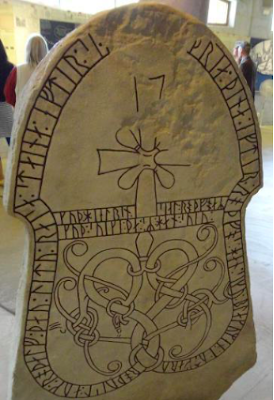 It is claimed that there are around 3000 runes stones in Scandinavia. I think that this claim is somewhat high, for looking at published maps of where they are to be found, there seems to be far fewer than 3000. However, it was not only in Scandinavia that runes were carved. There are Viking rune stones in England, Scotland, The Faroes, Greenland, Germany and Ukraine.
It is claimed that there are around 3000 runes stones in Scandinavia. I think that this claim is somewhat high, for looking at published maps of where they are to be found, there seems to be far fewer than 3000. However, it was not only in Scandinavia that runes were carved. There are Viking rune stones in England, Scotland, The Faroes, Greenland, Germany and Ukraine. When touring in Scandinavia, I have made a point of going out of my way to seek out the stones. A few are, to an historian, spectacular. The majority, while often richly decorated, have a simple message. Most are dedicated to a lost relative, a few are clearly meant to brag about the daring deeds of a person while they were still alive. The stone on the right falls into this category.
One of the most remarkable rune stones is the "Jelling Stone" in Denmark. This stone gives the first mention of Denmark being a "state" and that it had been Christianised. It can be dated very accurately, (965), and tells us that Harald Bluetooth claimed the unification of the country. There are in fact two large stones outside of the medieval church adjacent to huge burial mounds in Jelling. The largest, the Jelling Stone, is that which Harald ordered in memory of his father, King Gorm and his mother Queen Thyra. The other was ordered by King Gorm in memory of his wife.
I had a particular piece of luck when I visited Jelling. Despite the fragility of the carvings, the two stones had been left where they had first been placed, in the open air. Clearly, a decision had been made to move them into a protective glass cover, for when I arrived, a crane was lifting the smaller of the two stones. As I stood watching the stone rising from the ground there was excitement among the archaeologists - there was a man's skeleton directly under the stone. It had definitely been buried exactly under the setting of the stone. I immediately found myself wondering if this was a ritual sacrifice and what significance the burial had.
I would like to give two examples of how these stones have helped me in researching the background for stories.
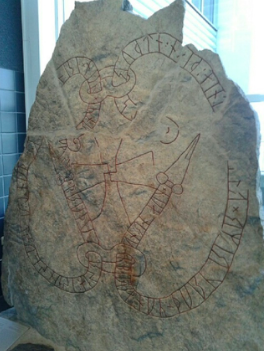 Visitors to Stockholm, travelling by BA, do not have far to go before they see their first rune stone. Just to the left of the Terminal 2, "Arrivals" entrance, there is a fine rune stone. Obviously, this is not its natural resting place. The stone was discovered when the motorway to the airport was being built. Like so many stones it seems to have been placed near an ancient bridge over wetlands. The runes on the stone have been translated as, “Gunnar and Björn and Thorgrim set up this stone in memory of Thorsten their brother. He died in the east with Ingvar and built this (bridge?).”
Visitors to Stockholm, travelling by BA, do not have far to go before they see their first rune stone. Just to the left of the Terminal 2, "Arrivals" entrance, there is a fine rune stone. Obviously, this is not its natural resting place. The stone was discovered when the motorway to the airport was being built. Like so many stones it seems to have been placed near an ancient bridge over wetlands. The runes on the stone have been translated as, “Gunnar and Björn and Thorgrim set up this stone in memory of Thorsten their brother. He died in the east with Ingvar and built this (bridge?).”The rune stone design gives a strong clue to the period when it was carved. In the centre of the traditional writhing snakes containing runic letters, futhark*, there is a cross. This indicates that it was made in the late Viking Age when the people of this region had embraced Christianity. That is not to say that the old pagan practices did not still hold sway and there is a very powerful symbol of this on the stone which shows this.
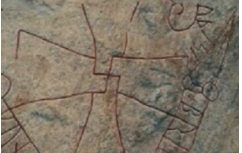 Right in the centre of the cross is a swastika. This symbol in Norse mythology denoted Thor, the principal sky god of the Viking Age. In the Norse tradition, his hammer was used to defend the gods’ celestial stronghold, Asgard, from the giants, the forces of chaos, decay, and destruction. The swastika was carved in the middle of the cross as a form of “double insurance” that the person being commemorated would be guaranteed to be taken from one state of being – that of chaos and weakness – to another – that of sacred order and strength. Use of the symbol in this way really does illustrate graphically how tenuous the foothold of Christianity was in Sweden at the time the rune stone was carved.
Right in the centre of the cross is a swastika. This symbol in Norse mythology denoted Thor, the principal sky god of the Viking Age. In the Norse tradition, his hammer was used to defend the gods’ celestial stronghold, Asgard, from the giants, the forces of chaos, decay, and destruction. The swastika was carved in the middle of the cross as a form of “double insurance” that the person being commemorated would be guaranteed to be taken from one state of being – that of chaos and weakness – to another – that of sacred order and strength. Use of the symbol in this way really does illustrate graphically how tenuous the foothold of Christianity was in Sweden at the time the rune stone was carved.A second significance of the stone is that there is a mention of what was perhaps the greatest disaster ever to befall a Viking expedition. The stone mentions Ingvar. In 1036, the 25-year-old Ingvar, a Viking chieftain later to be called “Ingvar the Far Travelled”, set off with a fleet of at least thirty ships and as many as 2000 men, to travel to the Middle East, to Serkland, the land of the Saracens. Serkland is the area around the Caspian Sea.
The purpose of the expedition was almost certainly a quest for gold. There are 26 runes stones in the area around Stockholm which commemorate men lost on the expedition and several of them mention gold. The stone at Gripsholm says, “"Tóla had this stone raised in memory of her son Haraldr, Ingvar's brother. They travelled valiantly far for gold, and in the east gave (food) to the eagle. (They) died in the south in Serkland." . “Food to the Eagle”, is a classic Viking way of saying that someone was killed.
According to a contemporary Georgian chronicle, dated to about 1040, around 2000 Norsemen had travelled from the Black Sea up the River Rioni to Basha. There they agreed to send 700 men to support the Georgian King Bagra in a battle against his enemies. Unfortunately, the battle was lost, but the victors agreed to let the Vikings go free. Legend has it that Ingvar then led his men to Baku in Azerbajan. What happened to the expedition after that is a complete mystery. It is said that just one ship returned to Sweden and the crew of this ship reported that the expedition had ended in disaster. See http://www.michaelwills.eu/?s=Ingvar+the+Far+Travelled for more background.
The second rune stone I would like to introduce gives a tantalizing glimpse of what, from the Viking perspective, was much more successful.
 A few kilometers north of Stockholm is a tiny village called Orkesta. The beautiful village church was built in the 12thcentury. Outside the church there are two rune stones which were placed there in 1977. Both of these stones mention the name of “Ulv”. One carving translates as, “Ulv raised this stone for Onäm, hjs uncle. They both lived in Borresta”. Borresta is an ancient estate to the west of Orkesta church. This a conventional rune stone inscription. However, the second stone is nothing short of sensational fodder for a novelist looking for background to a story.
A few kilometers north of Stockholm is a tiny village called Orkesta. The beautiful village church was built in the 12thcentury. Outside the church there are two rune stones which were placed there in 1977. Both of these stones mention the name of “Ulv”. One carving translates as, “Ulv raised this stone for Onäm, hjs uncle. They both lived in Borresta”. Borresta is an ancient estate to the west of Orkesta church. This a conventional rune stone inscription. However, the second stone is nothing short of sensational fodder for a novelist looking for background to a story.This second rune stone which is the basis of my present work in progress, “For The Want Of Silver”, translates as, “Ulv received danegeld in England three times. The first was (part of) Toste’s Danegeld, the second was (part of) Torkel’s, the third was (part of) Knut’s.”
It is often claimed that the “Toste” mentioned was Toste Skagul, a legendary chieftain from Swedish province of West Götaland, who is said to have raided England in 970. However, Sweden’s leading rune stone expert, Magnus Källström, emphatically denies that this is so, pointing out that Ulv of Borrestad would not hve been alive in 970.
The second person, Torkel was “Torkel the Tall”, commander of the dreaded “Jomsvikings”. He led a Viking army to raid Kent in 1009. After being paid a danegeld of 3000 pounds of silver to leave Canterbury, he went on to besiege London. He was unsuccessful and so in 1011, returned to Canterbury to claim another danegeld. However, the Archbishop refused to allow the danegeld to be paid and was taken prisoner. Then the story gets really ugly. A number of Torkel’s warriors mutinied. He offered them everything he owned, with the exception of his ship, to release the holy man who had previously converted him to Christianity. The chieftain’s offer was refused by the rebel warriors who savagely tormented the Archbishop and then murdered him. Torkel took those who were loyal to him and continued raiding southern England, eventually collecting 48,000 pounds of silver in danegeld.
The third name is that of King Canute. After being crowned King of England in 1017, he paid off his warriors with a huge sum of 82,500 pounds of silver to persuade them to go home.
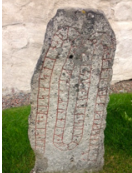 However, there is another story behind these two runestones. In 1868, an antiquarian called Richard Dybeck, carried out a search of the Orkesta area for a rune stone which was said to extend the text of the first one I mentioned above. He did not find it, but he discovered the second one above being used as a hearth stone at a farmstead. The extraordinary thing about this stone, apart from the message on it, is that the runes had been carved as a mirror image. That is, they had to be read from right to left. Why? It is most odd that Ulv’s story should be recorded in a way which rendered it almost impossible for anyone to read unless they could decipher runes backwards! Could it be that he wanted his story to be recorded for posterity but did not want to flaunt the fact that he had a stash of silver in his house?
However, there is another story behind these two runestones. In 1868, an antiquarian called Richard Dybeck, carried out a search of the Orkesta area for a rune stone which was said to extend the text of the first one I mentioned above. He did not find it, but he discovered the second one above being used as a hearth stone at a farmstead. The extraordinary thing about this stone, apart from the message on it, is that the runes had been carved as a mirror image. That is, they had to be read from right to left. Why? It is most odd that Ulv’s story should be recorded in a way which rendered it almost impossible for anyone to read unless they could decipher runes backwards! Could it be that he wanted his story to be recorded for posterity but did not want to flaunt the fact that he had a stash of silver in his house? My new book, a Viking story for young readers, called “Bound for Home”, was greatly inspired by the runes carved in Istanbul by Viking warriors employed by the Greek emperor. These runes, such as those carved on the lion statue seem to indicate that the warriors had plenty of time on their hands!
My new book, a Viking story for young readers, called “Bound for Home”, was greatly inspired by the runes carved in Istanbul by Viking warriors employed by the Greek emperor. These runes, such as those carved on the lion statue seem to indicate that the warriors had plenty of time on their hands!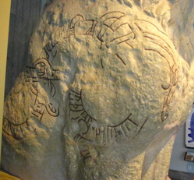 I could tell more, though I have much research left to do. A study of the stones produced outside Scandinavia beckons. And don’t think that the use of runes ceased at the end of the Viking Age. They were still in daily use in the 20th century. But that’s another story.
I could tell more, though I have much research left to do. A study of the stones produced outside Scandinavia beckons. And don’t think that the use of runes ceased at the end of the Viking Age. They were still in daily use in the 20th century. But that’s another story.*Futhark – the Viking runic alphabet in used at this time, named after its first six letters.
Children of the Chieftain – Bound for Home

The concluding book in the series. After three years in the service of the emperor of the Greeks, Ahl and his Viking friends have become very rich. Now the crew longs to return home with their wealth, their problem is that the emperor will not permit them to leave. They make a daring plan to escape. The route home is perilous as they navigate uncharted seas. They must overcome robbers, storms and hostile strangers as they seek their way back to the Northlands with the riches which they have earned.
Amazon
Michael E. Wills
 Michael E. Wills was born on the Isle of Wight, UK, and educated at the Priory Boys School and Carisbrooke Grammar. He trained as a teacher at St Peter’s College, Saltley, Birmingham, before working at a secondary school in Kent for two years.
Michael E. Wills was born on the Isle of Wight, UK, and educated at the Priory Boys School and Carisbrooke Grammar. He trained as a teacher at St Peter’s College, Saltley, Birmingham, before working at a secondary school in Kent for two years.After re-training to become a teacher of English as a Foreign Language he worked in Sweden for thirteen years. During this period, he wrote several English language teaching books. His teaching career has included time working in rural Sweden, a period that first sparked his now enduring interest in Scandinavian history and culture - an interest that after many years of research, both academic and in the field, led him to write “Finn’s Fate” and the sequel novel, “Three Kings – One Throne”. Continuing in a Viking theme, in June 2015, Michael published, “Children of the Chieftain: Betrayed”, the first of a quartet of Viking adventure stories for young readers. The book was described by the Historical Novel Society reviewer as “An absolutely excellent novel which I could not put down.” The novel was long-listed for the Historical Novel Society, 2016 Indie Prize. The second book in the quartet, “Children of the Chieftain: Banished”, was published in December 2015 followed by the third book, “Children of the Chieftain: Bounty”, which was published in 2017. The fourth and final book in the quartet. “Children of the Chieftain: Bound for Home”, has just been published.
Today, Michael works part-time as Ombudsman for English UK, the national association of English language providers. Though a lot of his spare time is spent with grandchildren, he also has a wide range of interests including researching for future books, writing, playing the guitar, carpentry and electronics.
Connect with Michael: Website • Facebook • Twitter
Published on April 29, 2019 23:00
The Coffee Pot Book Club Book Cover of the Month for April is — The Fourth Courier, by Timothy Jay Smith #HistoricalFiction #BookCover @TimothyJaySmith
The Coffee Pot Book ClubBook Cover of the Month
 Goes to...
Goes to...The Fourth Courier
By Timothy Jay Smith
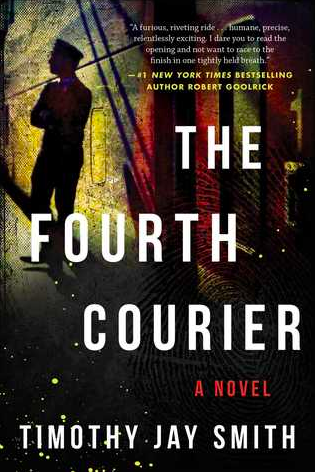
For International Espionage Fans of Alan Furst and Daniel Silva, a new thriller set in post-Soviet era Poland.
It is 1992 in Warsaw, Poland, and the communist era has just ended. A series of grisly murders suddenly becomes an international case when it's feared that the victims may have been couriers smuggling nuclear material out of the defunct Soviet Union. The FBI sends an agent to help with the investigation. When he learns that a Russian physicist who designed a portable atomic bomb has disappeared, the race is on to find him—and the bomb—before it ends up in the wrong hands.
Smith’s depiction of post-cold war Poland is gloomily atmospheric and murky in a world where nothing is quite as it seems. Suspenseful, thrilling, and smart, The Fourth Courier brings together a straight white FBI agent and gay black CIA officer as they team up to uncover a gruesome plot involving murder, radioactive contraband, narcissistic government leaders, and unconscionable greed.
Pick up you copy ofThe Fourth Courier
Amazon UK • Amazon US
Congratulations, Timothy!

Timothy Jay Smith
 Raised crisscrossing America pulling a small green trailer behind the family car, Timothy Jay Smith developed a ceaseless wanderlust that has taken him around the world many times. Polish cops and Greek fishermen, mercenaries and arms dealers, child prostitutes and wannabe terrorists, Indian Chiefs and Indian tailors: he hung with them all in an unparalleled international career that saw him smuggle banned plays from behind the Iron Curtain, maneuver through Occupied Territories, represent the U.S. at the highest levels of foreign governments, and stowaway aboard a 'devil's barge' for a three-days crossing from Cape Verde that landed him in an African jail.
Raised crisscrossing America pulling a small green trailer behind the family car, Timothy Jay Smith developed a ceaseless wanderlust that has taken him around the world many times. Polish cops and Greek fishermen, mercenaries and arms dealers, child prostitutes and wannabe terrorists, Indian Chiefs and Indian tailors: he hung with them all in an unparalleled international career that saw him smuggle banned plays from behind the Iron Curtain, maneuver through Occupied Territories, represent the U.S. at the highest levels of foreign governments, and stowaway aboard a 'devil's barge' for a three-days crossing from Cape Verde that landed him in an African jail.These experiences explain the unique breadth and sensibility of Tim's work, for which he's won top honors. Fire on the Island won the Gold Medal in the 2017 Faulkner-Wisdom Competition for the Novel. He won the Paris Prize for Fiction (now the Paris Literary Prize) for his novel, A Vision of Angels. Kirkus Reviews called Cooper's Promise "literary dynamite" and selected it as one of the Best Books of 2012. Tim was nominated for the 2018 Pushcart Prize. His screenplays have won numerous competitions. His first stage play, How High the Moon, won the prestigious Stanley Drama Award. He is the founder of the Smith Prize for Political Theater.
Connect with Timothy: Website • Twitter • Linkedin.
Published on April 29, 2019 21:00
April 28, 2019
Nothing’s Forgotten. Nothing is ever forgotten... Celebrating 35 years in the forest, by J.P. Reedman #RobinOfSherwood @StoneLord1
35 years in the forestBy J.P. Reedman
I first came upon Robin of Sherwood in early 1984. I was living in Canada but had crossed over to Port Angeles in the US to visit a friend—and recover from pneumonia. On the TV was an advert for a new cable station, Showtime—and a forthcoming new series, Robin of Sherwood.Immediately, I was captivated. This felt like MY Robin Hood. I’d loved the legend since around 5 years old, but always disliked most tv and film versions with their tights and silly caps and unrealistic swordfights. Robin of Sherwood had young actors, decent period clothing, real forests that were clearly English and real castles and abbeys instead of wobbly, fairytale sets.Later that year, I visited England for 5 months. I kept seeing snippets on Robin in teen magazines such as JACKIE, PATCHES and BLUE JEANS. I told myself I was a bit too old to be looking at such magazines…but I went ahead anyway!
The mid-80’s was a strange time socially and culturally; a time of change and flux. There was a raised interested in the ‘New Age’, paganism and folklore that hadn’t been seen since the 60’s, but was now it was entering the mainstream, rather than being part of a ‘counter culture’. History was becoming more popular and more appreciated too, with battle re-enactments taking place and the formation of English Heritage.
Many influential books and events came into my life between 1983-1986, with Robin being one of them—there was also Marion Zimmer Bradley’s Mists of Avalon and Sharon Penman’s Sunne in Splendour. I was still in the U.K. when Lindow Man, a preserved Iron Age body, was found in Lindow Moss, at Lammas, 1984, strange goings around a mound in Derbyshire hit the press, and the following year was the 500thAnniversary of Bosworth Field. ROS was part of that time, with its positive depiction of paganism and use of mysticism mixed with actual history; the myth of the Divine King who dies for the land mixed that of the merry trickster of the forest.
When I returned to Canada, I was frustrated. I really wanted to see all the series but it had not aired there. Videos of it would not be released for several years. Fate played its hand. I met my friend Dianne, who had ‘camera copies ‘of ALL the episodes (a camera copy was a shaky horror filmed from the TV with a video camera!) She also introduced me to fandom…and fanzines! At first, I resisted any organised fan-stuff but in May 1989 I went, with great nervousness, to my first convention in Seattle, with Michael Praed, Ray Winstone and Mark Ryan attending. And I was hooked. Totally. Within a short time, I was sending out fanfics and doing my own zine.
 Michael Praed.
Michael Praed.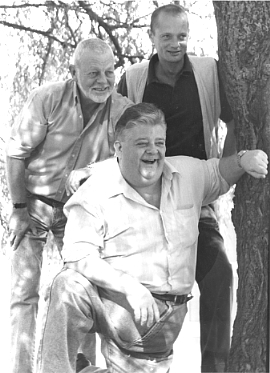 Terry Walsh, Phil Rose and Robert Addie.
Terry Walsh, Phil Rose and Robert Addie.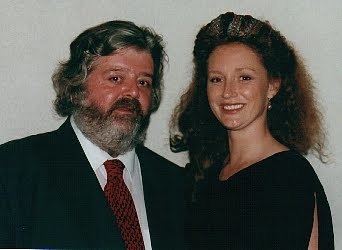 Phil Rose and Judi Trott
Phil Rose and Judi TrottSeveral years later, Michael Praed appeared in ‘Carousel’ in Dublin. Artist Frances Quinn kindly invited me to stay and I had a blast. I will forever have fond memories of the Tivoli Theatre and the little pub over the road…In 1992 I moved to the UK permanently and soon found out how popular ROS was still. Soon I was in talks regarding a convention—Albion. It was there I met my future partner, Dan, who was sitting directly across the table from me. A few years later, I was on the committee for a new convention, SILVER ARROW, which had something a bit different at the time—a location trip! We visited forests and castles by coach. We nearly had a disaster the first year when the party got lost, went off the track and climbed a massive hill muddy from the previous night’s rainfall. People were covered in mud—but thankfully, everyone survived. Some said that was their favourite bit!
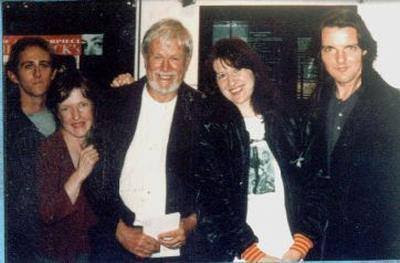 series creator Kip Carpenter with myself and Dan (on right.)
series creator Kip Carpenter with myself and Dan (on right.)Our last Silver Arrow took place in 2003. Several of the cast members had sadly passed away and we felt we could not continue to come up with new ideas. Over the years we had guests such as Michael Praed, Judi Trott, Robert Addie, Phil Rose, Nikolas Grace, series creator Richard Carpenter and wife Annabel Lee, Jeremy and Robbie Bulloch, Stuart Linden, Esta Charkham, and Anthony Valentine, and we had taken fans to visit Leigh and Blaise Woods, Chepstow and Farleigh Hungerford castles, Black Rock in Cheddar and Wells Cathedral. It was time to pass on the torch.
My interest in the series and the legend remains, however, and I am still in touch with some of the cast. My years of writing fanfic was invaluable practice for my other later original works; you would get feedback, and yes, fans WOULD definitely tell you if you ‘got it wrong’! While Dan and I don’t do fandom ‘activities’ these days, we still collect props and other memorabilia from the series—we have enough items to start our own Robin of Sherwood Museum (I wish!), including Michael’s costume, Robert’s armour and the sword Orias! My most treasured possessions.
The day in the 80’s when I heard the words ‘When the Hooded Man Comes to the Forest, There to Meet with Herne the Hunter, and Be his Son and Do His Bidding…’ was also the beginning of a great, ongoing adventure in Sherwood for me…
J.P. ReedmanLinks to my Robin of Sherwood-inspired series, THE HOOD GAME:HOOD GAME ROBIN HOOD SERIES
Published on April 28, 2019 23:30
#HistoricalFiction author, J.P. Reedman, is taking a look at Katherine Plantagenet — the maligned daughter of #RichardIII @StoneLord1
The Maligned King’s DaughterBy J.P. Reedman
Shakespeare’s famous play Richard III still defines many people’s beliefs about the last Plantagenet King, despite discrepancies such as Richard fighting battles when he would have been a toddler of two. The strangest, and perhaps, cruellest of Shakespeare’s ‘additions’, however, is probably making him childless—a misshapen monster who ‘dogs bark at’ and who appears to be consumed by envy of his handsome, womanising and rather prolific brother Edward. The truth, as in so many cases, is far more interesting than the invented story. Richard had a legitimate son, Edward of Middleham, who died between the ages of 7-10 and is the only Prince of Wales with no known grave, but he also had at least two illegitimate children, possibly three, and there are vague suggestions, although with less evidence to back them up, that there may have been more! So not exactly the neglected ‘ugly brother’ who couldn’t ‘get the girl.’One of the children we know definitely existed was Katherine Plantagenet. We are not sure of her date of birth or if shared the same mother as her brother John of Gloucester. Possibilities for Katherine’s mothers might be Katherine Haute who was given a lifelong pension by Richard; she bears the same name as his daughter, and it wasn’t one particularly common in his family. However, Richard gave quite a few pensions to women in their own right so it is impossible to say for certain.Whoever her mother was, he acknowledged Katherine as his daughter and gave her his name. We don’t know where she was educated but Richard seemed to have had it in hand; Sheriff Hutton Castle has been suggested.When he became King, Richard found a fitting match for his illegitimate daughter. Katherine was married into the nobility in 1484, as the second wife of William Herbert, earl of Huntingdon. This may give us a clue as to her age at the time; since she went to her husband’s home immediately, she was probably over fourteen, maybe closer to sixteen. She lived at beautiful Raglan Castle in Wales.

However, after Richard’s death at Bosworth, Katherine disappears from the records. It seems she died young for her husband, William Herbert, is listed as a ‘widower’ when attending Elizabeth of York’s Coronation in 1487. Some have speculated she died in childbirth, not an unreasonable guess with mother and infant mortality so high at the time, others that she may have died from the Sweat, which first appeared in England around the time Henry Tudor invaded with his foreign troops. One fiction writer had Henry VII shut her up in the Tower, and this gained some currency as a true story, but this is almost certainly false—however, her brother John is probably the ‘son of Richard III’ later incarcerated in the Tower and said to have been executed around 1491.Whatever happened, Katherine’s brief story almost disappeared and, like her father and brothers, her gravesite was lost in time.Then a few years ago, Dr Christian Steer discovered a copy of a 16th herald’s roll listing the monuments in London Churches. In St James Garlickhythe there was said to be the grave of ‘the countesse of huntyngdon ladie Herbert wtout a stone’. There were several Lady Herberts over the centuries but only one who was Countess of Huntingdon. Katherine, long lost, was found. Checking in John Stow’s 16th c Survey of London, I actually found her again listed as the ‘The Countess of Huntingdon; the Lady Harbert’. A typo and misplaced semi-colon but undoubtedly the same grave and the same person. So, she was hiding in ‘plain sight’ all along….

In my novella ‘The White Rose Rent’ I tried to reconstruct Katherine’s short life based on what little we know mixed with necessary creations of my own. A few people on the book’s release seemed a little shaken and asked, “Where’s Shakespeare’s Richard? Did he even HAVE a daughter?”I’d be inclined to say, the first did not exist—and the second, without a doubt, did, and deserves a story of her own.

Pick up your copy of The White Rose RentAmazon
J.P. Reedman
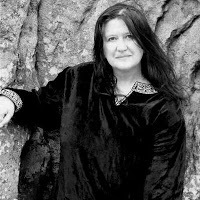 J.P. Reedmanwas born in Canada but has lived in the U.K. for nearly 25 years. Interests include folklore & anthropology, prehistoric archaeology (Neolithic/Bronze age Europe; ritual, burial & material culture), as well as The Wars of the Roses and other medieval periods. Novels include I, Richard Plantagenet and the Man Who Would be King (Wars of the Roses), The Hood Game (Robin Hood), THE STONEHENGE SAGA (bronze Age), and MEDIEVAL BABES, a series about little-known Medieval women.
J.P. Reedmanwas born in Canada but has lived in the U.K. for nearly 25 years. Interests include folklore & anthropology, prehistoric archaeology (Neolithic/Bronze age Europe; ritual, burial & material culture), as well as The Wars of the Roses and other medieval periods. Novels include I, Richard Plantagenet and the Man Who Would be King (Wars of the Roses), The Hood Game (Robin Hood), THE STONEHENGE SAGA (bronze Age), and MEDIEVAL BABES, a series about little-known Medieval women.
Published on April 28, 2019 23:00
April 27, 2019
Celebrating 35 years of Robin of Sherwood: Special Guest Interview – Clive Mantle #RobinOfSherwood @MantleClive
Nothing’s forgotten. Nothing is ever forgotten.
Celebrating 35 years of Robin of Sherwood.
Exclusive Guest Interview with the fabulousClive Mantle

There have been many retellings of the story of Robin Hood, but one of the most enduring has to be the 1980’s television series Robin of Sherwood. Today I am joined by the fabulous Clive Mantle, who fans of the show will know played the down-to-earth and extremely memorable, Little John.
Hi Clive, it is such an honour to have you on Myth’s, Legends, Books & Coffee Pots today. Little John was such an integral part of the Robin Hood story. How did the role of Little John first come to your attention?
Esta Charkham, who cast it, knew me from the National Youth Theatre, and got in touch with my agent. As far as I knew it was going to be the normal process of dozens of actors trooping in one by one until they got who they wanted. How wrong was I !!
I walked into a small office at Pinewood and was immediately hugged by Paul Knight, the producer, and more or less welcomed aboard. I was flabberghasted. He and Kip Carpenter had seen me play Little John in a glorious stage production at the Young Vic Theatre in London, completely unbeknownst to me, and had practically decided there and then.
So I was the only person seen for the part amazingly. It was my luckliest break. Great men both, with the brilliant Esta championing my cause. I owe them all a great debt of gratitude.

You had the part before you even auditioned, that must have been an amazing feeling, but I am not surprised. No one could have played Little John as you did. Did you do any background research into your character?
I had been a part of a superb stage version directed by David Toguri, and written by Dave and Toni Arthur. It bore very little resemblance to the TV series, but the voice and the headstrong emotional side of the character I’d worked on already.

You were born to play Little John, then! How much influence did you have on how Little John was portrayed?
Kip listened to us and wrote to our strengths as he got to know us. We had regular meetings in various hotel bars and suggested things to him, most of which emerged in one form or another.
What was the atmosphere like on set?
Never before or since have I had such a wonderful time at work. A constant joy and a pleasure from beginning to end. I wish we were still making them today. The cast and crew were very special and an unbreakable bond united us all from in front and behind the camera. It was set up by the great Ian Sharp, who laid down the way things would be done, and with our social secretary, Ray Winstone, in charge of japes and wind-ups, life was never dull.

There is a real sense of Good vs Evil in Robin of Sherwood, and there were some very memorable villains. Who was your favourite villain and why?
Anthony Valentine I think, although they were all wonderful. Anthony was the stillest and most frightening and the greatest pleasure to work with, as I had quite a lot to do with him.
As a child I was terrified of Anthony Valentine’s character, ‘Baron Simon de Belleme,’ but not enough to stop me from watching! He was the most deplorable villain — very sinister.
Little John’s choice of weapon was the quarterstaff. How long did it take you to learn to use a quarterstaff and were they any accidents?
Terry Walsh, our supreme stunt coordinator altered my approach from the word go, and said I should use it like a rifle and bayonet and not let people with swords near me. It was a great thing to say and I responded well to it. It sparked my imagination and many Norman soldiers got a taste of the sharp end.
Always little knicks and cuts, and I put my back out once, but we escaped largely unharmed.

You certainly looked very impressive on the television with your quarterstaff. My siblings and myself used to play Robin Hood in the woods, and we always ended up making quarterstaffs out of small branches we found on the floor. We all came away with bruises too!
Who was the best shot with a bow and arrow? Who was the worst?
Praedy was pretty good I seem to remember, or maybe he just tells me that a lot, and the mists of time have obscured the truth.
Ray actually broke a lens by loosing an arrow at an automatic camera set up alongside a target, but I wouldn’t call him the worse shot to his face I can tell you that for nothing.
 Ray Winstone (Will Scarlet), Clive Mantle (Little John), Mark Ryan (Nasir).
Ray Winstone (Will Scarlet), Clive Mantle (Little John), Mark Ryan (Nasir).I am sure Michael doesn’t exaggerate his prowess with a bow and arrow, at all, and I am sure Ray meant to hit the camera lens!! What was your most memorable scene while filming?
It’s so long ago now, I enjoyed every minute, but ‘The King’s Fool” and the argument with Robin probably stands out for me.
The King’s Fool was such a great episode. Did Robin of Sherwood change your life in any way?
Completely and utterly changed my life and my standing in the business. It was a remarkable show to be part of and I’m the luckiest actor alive to have been part of it.
Do you still keep in touch with any of the cast?
No, as you can tell, I hate them all !!!
We all still see a lot of each other even though some of our number spend great chunks of time abroad. We see each other at events like conventions and sadly now funerals, but the last time we were all in the same room, apart from Phil who was sorely missed, was at my 60th Birthday party 2 years ago.
 Jason Connery (Robin) , Mark Ryan (Nasir) , Clive Mantle (Little John), Peter Llewellyn Williams Much), Phil Rose (Friar Tuck).
Jason Connery (Robin) , Mark Ryan (Nasir) , Clive Mantle (Little John), Peter Llewellyn Williams Much), Phil Rose (Friar Tuck). Mark Ryan, Clive Mantle, Jason Connery.
Mark Ryan, Clive Mantle, Jason Connery.Thirty-Five years on and Robin of Sherwood is still enjoyed by so many people. What kind of legacy do you hope Robin of Sherwood will leave for future generations?
It’s a heartfelt telling of the tales of Robin, told with love and passion, and the absolute need for justice running like a spine throughout.
Other people have tried since and have offered pale imitations of what we all achieved. Sooner or later a new version will eclipse ours, but only when a writer of Kip’s compassion, moral strength, drama and vision tackles the sagas. Not many of them about.
Happy Days all of you.
Thank you so much Clive for the special insight into Robin of Sherwood.
As well as a brilliant actor, Clive is also a children’s author. Check out Clive’s first book, in what promises to be a very exciting, series:
The Treasure at the Top of the World(A Freddie Malone Adventure Book 1)
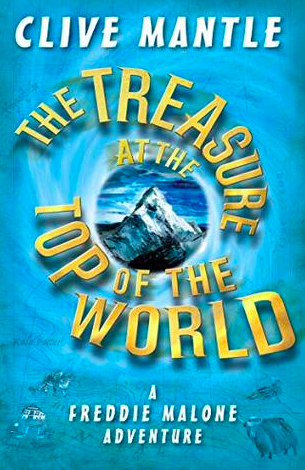
When Freddie Malone is given an ancient map for his birthday by his eccentric Uncle Patrick, it seems an odd gift, but Freddie is thrilled. Little does he realise that the mysterious map is about to turn his world upside down. Plunged into a perilous adventure between two worlds, and pursued in turn by a ruthless bully and a determined adversary who will each go to any lengths to get what they want, Freddie must fight for what’s right – and for his very life…
Clive Mantle brings all the drama of his TV, film and stage career to the first in a thrilling series of incredible time-travel adventures.
The Treasure at the Top of the World
is available to purchase:
Amazon UK • Amazon US
Or, ask your local bookstore.
Clive Mantle
 Clive Mantle is a much-loved British actor, a star of both stage and screen for over 40 years. He is perhaps best known for playing Little John in Robin of Sherwood, Great Jon Umber in Game of Thrones, Simon Horton in The Vicar of Dibley and Mike Barratt in Casualty. His voice is also well known from his work on over 180 audio books, and voicing animated characters, including Gator in Thomas the Tank Engine...
Clive Mantle is a much-loved British actor, a star of both stage and screen for over 40 years. He is perhaps best known for playing Little John in Robin of Sherwood, Great Jon Umber in Game of Thrones, Simon Horton in The Vicar of Dibley and Mike Barratt in Casualty. His voice is also well known from his work on over 180 audio books, and voicing animated characters, including Gator in Thomas the Tank Engine......And, he is now a published Author.
'The Treasure at the Top of the World' was released on 24th May 2018.
Connect with Clive: Website • The Adventures of Freddie Malone • Facebook •Twitter.
References:
All images have been supplied by Clive Mantle.
Published on April 27, 2019 23:00
April 26, 2019
Celebrate 35 years of Robin of Sherwood with Historical Fiction author and #RobinofSherwood audio script writer — Jennifer Ash @JenAshHistory
Nothing’s forgotten. Nothing is ever Forgotten.35 years of Robin of Sherwood
Robin Hood DreamingBy Jennifer Ash (Jenny Kane)
At the age of fourteen I fell in love. This was no teenage crush on a boy from school or a singer or film star. I had fallen for Robin Hood. Any Robin Hood. (Apart from Russell Crowe – there are limits).
This intense interest in a man of legend began when I watched the hit ITV series Robin of Sherwood, back in the 1980’s. Within an hour of seeing my first episode I was digging through my parent’s study for a book on myths and legends. From that moment on I was, unbeknown to me, setting the course for the rest of my life.

Four years later, having read every text book and story book on Robin Hood I could find, I studied archaeology and medieval history at university, and then went on to complete a doctorate on the comparison between real medieval crimes and those described in fourteenth century literature.
The earliest mention found (to date) of the name Robin Hood in literature appears in the poem The Vision of Piers Plowman; written by William Langland in c.1377. This was a long protest poem complaining about the harsh conditions endured by the poor in the Fourteenth Century. Not only did it mention Robin Hood, but it also makes reference to a real criminal gang; the Folville family.
“And some ryde and to recovere that unrightfully was wonne:He wised hem wynne it ayein wightnesses of handes,And fecchen it from false men with Folvyles lawes.”

It is this family, the Folvilles from Leicestershire, who were to become the catalyst for the novels written under my third the pen name, Jennifer Ash. In 1310, John de Folville, Lord of Ashby Folville, died, leaving his widow Alice and seven sons. The eldest son, also John, inherited the Ashby-Folville manor. He had six brothers; Eustace, Laurence, Richard, Robert, Thomas and Walter, who formed a notorious gang. Between the mid 1320’s and 1330’s, the Folville brothers ran the town of Ashby-Folville and its surrounds as a base for criminal activity.
The first crime that brought the Folvilles to the notice of the authorities was the murder of the Baron of the Exchequer, Roger Belers. Over the following decade, the Folville brothers’ travelled the countryside assaulting those they considered deserving of such treatment, and holding people and places to ransom. They hired themselves out as mercenaries, willing to commit crimes for the right price. In fact, if you look closely enough at the criminal activities of the Folville family and the Robin Hood ballads, you’ll see a great number of similarities. So many in fact, that I began to wonder if the ballad writers had been influenced by the actions of Folvilles or if Folvilles had been influenced by the popularity of the ballads.

It was this latter theory that formed the inspiration behind The Folville Chronicles (The Outlaw’s Ransom, The Winter Outlaw and Edward’s Outlaw). This series of medieval murder mysteries shows Robert de Folville and his brothers using the ballads of Robin and his outlaws as a code of behaviour. Be warned however- this isn’t the code of behaviour we associate with Robin Hood today. There’s no robbing the rich to give to the poor. The ballads were all about punishing the greedy, lazy and the cruel. There was never any question of money gained from their felonies being given away.
Perhaps it was inevitable that this research, combined with my love for the stories of Robin Hood, would inspire my novels. However, it took several years of writing romantic comedies before I was brave enough to use my medieval research in fiction. When I finally did, I was rather sneaky about it.

I’d had some measure of success as Jenny Kane, and so changing genres was a big step. Rather than leap in, I decided to write a contemporary novel about a medieval lecturer called Grace Harper, who’s so obsessed with Robin Hood that real life is passing her by. Split in half, Romancing Robin Hood tells Grace’s story, as well as the story of Mathilda of Twyford- a nineteen year old potter’s daughter who has the misfortune to cross the Folvilles.
When you’re in love with a man of legend, how can anyone else match up?Dr Grace Harper has loved the stories of Robin Hood ever since she first saw them on TV as a teenager. Now, with her fortieth birthday just around the corner, she’s a successful academic in Medieval History—but Grace is stuck in a rut.
Grace is supposed to be writing a textbook on a real-life medieval criminal gang—the Folvilles—but instead she is captivated by a novel she’s secretly writing. A medieval mystery which entwines the story of Folvilles with her long-time love of Robin Hood—and a feisty young woman named Mathilda of Twyford.
Just as she is trying to work out how Mathilda can survive being kidnapped by the Folvilles, Grace’s best friend Daisy announces she is getting married. After a whirlwind romance with a man she loves as much as the creatures in her animal shelter, Daisy has press-ganged Grace into being her bridesmaid.
Witnessing Daisy’s new-found happiness, Grace starts to re-evaluate her own life. Is her devotion to a man who may or may not have lived hundreds of years ago really a substitute for a real-life hero of her own? Grace’s life doesn’t get any easier when she meets Dr Robert Franks—a rival academic who she is determined to dislike but finds herself being increasingly drawn to… If only he didn’t know quite so much about Robin Hood.Suddenly, spending more time living in the past than the present doesn’t seem such a good idea...Such was the popularity of the medieval part of the novel that it led to the writing of the aforementioned Folville Chronicles. (The Outlaw’s Ransom is taken directly from Mathilda’s story in Romancing Robin Hood.)
As luck would have it- the modern part of the story was also popular. In fact, it led to a small miracle. Thirty years after Robin of Sherwood finished on television, the cast are back together making audio versions of the series. Having come across Romancing Robin Hood, the audio series creators invited me to write four scripts for Michal Praed, Jason Connery and the rest of the team to read. I honestly can’t believe my luck! I never dreamt that a teenage obsession would become the inspiration for so much of my adult writing life.
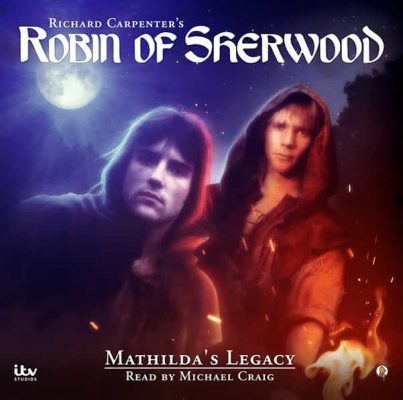
Find out more about Jennifer Ash’s books:
Romancing Robin HoodThe Folville ChroniclesThe Outlaw’s RansomThe Winter Outlaw Edward’s Outlaw
Jennifer Ash (Jenny Kane)
 Influenced by a lifelong love of Robin Hood and medieval ballad literature, Jennifer wrote The Folvilles Chronicles: The Outlaw’s Ransom, The Winter Outlawand Edward’s Outlaw (LittwitzPress, 2017- 2018). The fourth novel in this historical murder mystery series will be published in 2020.
Influenced by a lifelong love of Robin Hood and medieval ballad literature, Jennifer wrote The Folvilles Chronicles: The Outlaw’s Ransom, The Winter Outlawand Edward’s Outlaw (LittwitzPress, 2017- 2018). The fourth novel in this historical murder mystery series will be published in 2020.
Jennifer also writes as Jenny Kane. Her work includes the romantic comedies, Romancing Robin Hood (2ndedition, Littwitz Press, 2018), Abi’s Neighbour (Accent Press, 2017),Another Glass of Champagne (Accent Press, 2016), and the bestsellers, Abi’s House (Accent Press, June 2015), and Another Cup of Coffee (Accent Press, 2013). All of Jennifer and Jenny Kane’s news can be found at
Connect with Jennifer: Website • Twitter • Facebook • BookBub• Goodreads
Robin Hood DreamingBy Jennifer Ash (Jenny Kane)
At the age of fourteen I fell in love. This was no teenage crush on a boy from school or a singer or film star. I had fallen for Robin Hood. Any Robin Hood. (Apart from Russell Crowe – there are limits).
This intense interest in a man of legend began when I watched the hit ITV series Robin of Sherwood, back in the 1980’s. Within an hour of seeing my first episode I was digging through my parent’s study for a book on myths and legends. From that moment on I was, unbeknown to me, setting the course for the rest of my life.

Four years later, having read every text book and story book on Robin Hood I could find, I studied archaeology and medieval history at university, and then went on to complete a doctorate on the comparison between real medieval crimes and those described in fourteenth century literature.
The earliest mention found (to date) of the name Robin Hood in literature appears in the poem The Vision of Piers Plowman; written by William Langland in c.1377. This was a long protest poem complaining about the harsh conditions endured by the poor in the Fourteenth Century. Not only did it mention Robin Hood, but it also makes reference to a real criminal gang; the Folville family.
“And some ryde and to recovere that unrightfully was wonne:He wised hem wynne it ayein wightnesses of handes,And fecchen it from false men with Folvyles lawes.”

It is this family, the Folvilles from Leicestershire, who were to become the catalyst for the novels written under my third the pen name, Jennifer Ash. In 1310, John de Folville, Lord of Ashby Folville, died, leaving his widow Alice and seven sons. The eldest son, also John, inherited the Ashby-Folville manor. He had six brothers; Eustace, Laurence, Richard, Robert, Thomas and Walter, who formed a notorious gang. Between the mid 1320’s and 1330’s, the Folville brothers ran the town of Ashby-Folville and its surrounds as a base for criminal activity.
The first crime that brought the Folvilles to the notice of the authorities was the murder of the Baron of the Exchequer, Roger Belers. Over the following decade, the Folville brothers’ travelled the countryside assaulting those they considered deserving of such treatment, and holding people and places to ransom. They hired themselves out as mercenaries, willing to commit crimes for the right price. In fact, if you look closely enough at the criminal activities of the Folville family and the Robin Hood ballads, you’ll see a great number of similarities. So many in fact, that I began to wonder if the ballad writers had been influenced by the actions of Folvilles or if Folvilles had been influenced by the popularity of the ballads.

It was this latter theory that formed the inspiration behind The Folville Chronicles (The Outlaw’s Ransom, The Winter Outlaw and Edward’s Outlaw). This series of medieval murder mysteries shows Robert de Folville and his brothers using the ballads of Robin and his outlaws as a code of behaviour. Be warned however- this isn’t the code of behaviour we associate with Robin Hood today. There’s no robbing the rich to give to the poor. The ballads were all about punishing the greedy, lazy and the cruel. There was never any question of money gained from their felonies being given away.
Perhaps it was inevitable that this research, combined with my love for the stories of Robin Hood, would inspire my novels. However, it took several years of writing romantic comedies before I was brave enough to use my medieval research in fiction. When I finally did, I was rather sneaky about it.

I’d had some measure of success as Jenny Kane, and so changing genres was a big step. Rather than leap in, I decided to write a contemporary novel about a medieval lecturer called Grace Harper, who’s so obsessed with Robin Hood that real life is passing her by. Split in half, Romancing Robin Hood tells Grace’s story, as well as the story of Mathilda of Twyford- a nineteen year old potter’s daughter who has the misfortune to cross the Folvilles.
When you’re in love with a man of legend, how can anyone else match up?Dr Grace Harper has loved the stories of Robin Hood ever since she first saw them on TV as a teenager. Now, with her fortieth birthday just around the corner, she’s a successful academic in Medieval History—but Grace is stuck in a rut.
Grace is supposed to be writing a textbook on a real-life medieval criminal gang—the Folvilles—but instead she is captivated by a novel she’s secretly writing. A medieval mystery which entwines the story of Folvilles with her long-time love of Robin Hood—and a feisty young woman named Mathilda of Twyford.
Just as she is trying to work out how Mathilda can survive being kidnapped by the Folvilles, Grace’s best friend Daisy announces she is getting married. After a whirlwind romance with a man she loves as much as the creatures in her animal shelter, Daisy has press-ganged Grace into being her bridesmaid.
Witnessing Daisy’s new-found happiness, Grace starts to re-evaluate her own life. Is her devotion to a man who may or may not have lived hundreds of years ago really a substitute for a real-life hero of her own? Grace’s life doesn’t get any easier when she meets Dr Robert Franks—a rival academic who she is determined to dislike but finds herself being increasingly drawn to… If only he didn’t know quite so much about Robin Hood.Suddenly, spending more time living in the past than the present doesn’t seem such a good idea...Such was the popularity of the medieval part of the novel that it led to the writing of the aforementioned Folville Chronicles. (The Outlaw’s Ransom is taken directly from Mathilda’s story in Romancing Robin Hood.)
As luck would have it- the modern part of the story was also popular. In fact, it led to a small miracle. Thirty years after Robin of Sherwood finished on television, the cast are back together making audio versions of the series. Having come across Romancing Robin Hood, the audio series creators invited me to write four scripts for Michal Praed, Jason Connery and the rest of the team to read. I honestly can’t believe my luck! I never dreamt that a teenage obsession would become the inspiration for so much of my adult writing life.

Find out more about Jennifer Ash’s books:
Romancing Robin HoodThe Folville ChroniclesThe Outlaw’s RansomThe Winter Outlaw Edward’s Outlaw
Jennifer Ash (Jenny Kane)
 Influenced by a lifelong love of Robin Hood and medieval ballad literature, Jennifer wrote The Folvilles Chronicles: The Outlaw’s Ransom, The Winter Outlawand Edward’s Outlaw (LittwitzPress, 2017- 2018). The fourth novel in this historical murder mystery series will be published in 2020.
Influenced by a lifelong love of Robin Hood and medieval ballad literature, Jennifer wrote The Folvilles Chronicles: The Outlaw’s Ransom, The Winter Outlawand Edward’s Outlaw (LittwitzPress, 2017- 2018). The fourth novel in this historical murder mystery series will be published in 2020.Jennifer also writes as Jenny Kane. Her work includes the romantic comedies, Romancing Robin Hood (2ndedition, Littwitz Press, 2018), Abi’s Neighbour (Accent Press, 2017),Another Glass of Champagne (Accent Press, 2016), and the bestsellers, Abi’s House (Accent Press, June 2015), and Another Cup of Coffee (Accent Press, 2013). All of Jennifer and Jenny Kane’s news can be found at
Connect with Jennifer: Website • Twitter • Facebook • BookBub• Goodreads
Published on April 26, 2019 22:00
Nothing’s forgotten. Nothing is ever Forgotten: 35 years of Robin of Sherwood #RobinOfSherwood #RobinHood
Published on April 26, 2019 21:30
April 25, 2019
Join me in conversation with #HistoricalFiction author, Jayne Davis #mustread #Interview @jaynedavis142
Join me in conversation with Historical Fiction author, Jayne Davis.
Please give a warm Coffee Pot welcome to Historical Fiction author, Jayne Davis!
Jayne, could you tell my readers a little about yourself!
I’ve wanted to write novels since I was in school, but only got around to taking it seriously 40 years later, after having been an engineer, a teacher and a publisher of school text books. After the last ‘proper’ job I went freelance and earned a living writing textbooks for over ten years before the fiction bug gripped me. I write under Jayne Davis, rather than my real name, as I don’t think school science and historical romance would help to sell each other.
I live in a village just north of Bristol, in England, with a partner and a garden, but no cat. If I’m not writing or weeding, I’ve got my nose in a book, or I’m skiving off by cycling or walking in the local countryside.
No cat?! How can you be a writer and not have a cat? Actually, I don’t have a cat either! On a more serious note, what inspired you to write Sauce for the Gander?
I got hooked on Jane Austen and Georgette Heyer as a teenager, and I’ve always wanted to write that kind of story. When my friends found out I had published a novel, they were all surprised I wasn’t writing science fiction or thrillers.
My latest book, Sauce for the Gander, is the first in The Marstone Series, a set of standalone stories linked by the character of Will, who will become the Earl of Marstone in later books. It was an interesting plot to develop, as I already have a rough draft of Book 3, in which Will is an important secondary character. So I knew where the character had to end up, which gave me the non-romance parts of the plot. Book 3 is nearly ready for editing, but won’t see the light of day until I’ve published Book 2 – which is still just ideas at the moment. My aim for future books is to be more organised and write them in the correct order!
Your series sounds amazing. What were the challenges you faced in researching this period of history?
My first book, The Mrs MacKinnons, is set in 1800. Sauce for the Gander is set in 1777, and The Marstone Series will span the time up to around 1800. A lot of my initial feel for the era came from reading Georgette Heyer’s novels—she is widely regarded as having done meticulous research. There are also a lot of general books about the period, thanks in part to fans of Jane Austen.
I am also interested in the Peninsular War, 1809-1814, and hope to write stories based on soldiers in that war, or returning from it. There are many accounts written by officers, and quite a few by private soldiers. I have also been extravagant and been on a battlefield tours holiday, with an expert guide. It makes a huge difference to understanding what happened to see the locations.
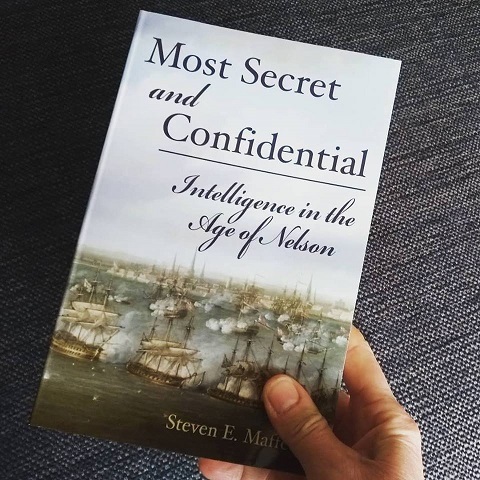
My main challenge is having too many research books to read—my TBR pile for non-fiction is growing. Having a liking for second hand bookshop encourages this; my favourite is the old cinema shop in Hay on Wye.
I know the feeling with regards to the TBR pile! There are many books about Georgian and Regency England. Can you tell us three things that set your novels apart?
Many of the romances set in this period have a titled hero, frequently a duke. And quite often these dukes have friends who are also dukes. There really were never very many dukes at any one time, let alone all of them being single, rich and attractive men of the right age for romance! So one thing I am trying to make different is to not have all my heroes as high-ranking aristocrats. Some will be, but hopefully many will not.
I’m also trying to follow the lead of some of the best authors in the genre, and write a story that really might have happened in that time period. Too many stories in the genre are fairly modern romances but with heroines in long dresses.
For my third thing—I try to have characters on my cover wearing clothing reasonably close to the correct period. This is not easy, unless you have a huge budget for commissioned photos.
The more I hear about your book the more I want to read it! Can you tell us what you are currently working on?
I should be working on Book 2 of The Marstone Series, but while I was on a walking holiday in Wales last autumn, I got to thinking about a few Regencies where our heroine is threatened with being sent to their aunt in Wales as some kind of punishment. I wondered what would happen if the aunt was not a dragon, and the next miles were taken up with working out the basics of what will become a novella called An Embroidered Spoon.
I’ve just finished A Winning Trick, which is a 20,000 word novella that is effectively an extended epilogue to Sauce for the Gander. It will be free (ebook only) to readers who join my mailing list.
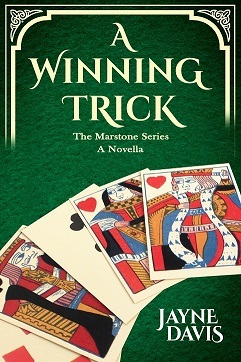
Sauce for the Gander
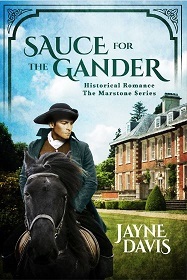
A duel. An ultimatum. An arranged marriage.England, 1777Will, Viscount Wingrave, whiles away his time gambling and bedding married women, thwarted in his wish to serve his country by his controlling father.News that his errant son has fought a duel with a jealous husband is the last straw for the Earl of Marstone. He decrees that Will must marry. The earl’s eye lights upon Connie Charters, unpaid housekeeper and drudge for a poor but socially ambitious father who cares only for the advantage her marriage could bring him.Will and Connie meet for the first time at the altar. But Connie wants a husband who will love and respect her, not a womaniser and a gambler.Their new home, on the wild coast of Devonshire, conceals dangerous secrets that threaten them and the nation. Can Will and Connie overcome the forces against them and forge a happy life together?
Pick up your copy ofSauce for the Gander
Amazon
Read for FREE on

Jayne Davis
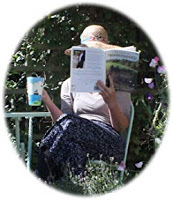 Jayne Davis writes historical romances set in the late Georgian/Regency era, published as both ebooks and paperbacks.She was hooked on Jane Austen and Georgette Heyer as a teenager, and longed to write similar novels herself. Real life intervened, and she had several careers, including as a non-fiction author under another name. That wasn't quite the writing career she had in mind...Finally, she got around to polishing up stories written for her own amusement in long winter evenings, and became the kind of author she’d dreamed of in her teens. She is now working on the first few books in the Marstone Series, set in the late Georgian/early Regency period.
Jayne Davis writes historical romances set in the late Georgian/Regency era, published as both ebooks and paperbacks.She was hooked on Jane Austen and Georgette Heyer as a teenager, and longed to write similar novels herself. Real life intervened, and she had several careers, including as a non-fiction author under another name. That wasn't quite the writing career she had in mind...Finally, she got around to polishing up stories written for her own amusement in long winter evenings, and became the kind of author she’d dreamed of in her teens. She is now working on the first few books in the Marstone Series, set in the late Georgian/early Regency period.You can find Jayne: Website • Pinterest.
Published on April 25, 2019 23:00
The Coffee Pot Book Club
The Coffee Pot Book Club (formally Myths, Legends, Books, and Coffee Pots) was founded in 2015. Our goal was to create a platform that would help Historical Fiction, Historical Romance and Historical
The Coffee Pot Book Club (formally Myths, Legends, Books, and Coffee Pots) was founded in 2015. Our goal was to create a platform that would help Historical Fiction, Historical Romance and Historical Fantasy authors promote their books and find that sometimes elusive audience. The Coffee Pot Book Club soon became the place for readers to meet new authors (both traditionally published and independently) and discover their fabulous books.
...more
...more
- Mary Anne Yarde's profile
- 159 followers



